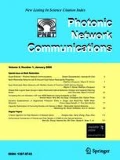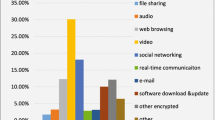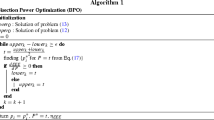Abstract
In this paper, an energy efficient adaptive optical code division multiple access (OCDMA) random access protocol based on particle swarm optimization (PSO) is described. This protocol is based on the S-ALOHA with power and rate allocation based on PSO. This scheme evaluates jointly optimal power and rate allocation PSO based under the random access protocol as a new and simplified scheme for high performance, high energy efficiency suitable for OCDMA systems. The aim is to maximize the aggregate throughput, subject to predetermined quality of service restrictions and energy efficiency constraint in terms of the signal-to-noise-plus interference ratio of each user class. Numerical results are discussed taking into account realistic network operation scenario.










Similar content being viewed by others
References
Wong, E.: Next-generation broadband access networks and technologies. J. Lightwave Technol. 30(4), 597–608 (2012)
Valcarenghi, L., et al.: Energy efficiency in passive optical networks: where, when, and how? IEEE Netw. 26, 61–68 (2012)
Mukai, H., Tano, F., Nakagawa, J.: Energy efficient 10G-EPON system. In: Proceedings of OFC/NFOEC, Anaheim, CA, March 2013, paper OW3G.1
Tucker, R.S.: Green optical communications—part I: energy limitations in transport. J. Sel. Quantum Electron. 17(2), 245–260 (2011)
Cvijetic, N., Qian, D., Hu, J.: 100 Gb/s optical access based on optical orthogonal frequency-division multiplexing. IEEE Commun. Mag. 48(7), 70–77 (2010)
Effenberger, F.J.: The XG-PON system: cost effective 10 Gb/s access. J. Lightwave Technol. 29(4), 403–409 (2011)
Fouli, K., Maier, M.: Ocdma and optical coding: principles, applications, and challenges. IEEE Commun. Mag. 45(8), 27–34 (2007)
Yin, H., Richardson, D.J.: Optical Code Division Multiple Access Communication Networks: Theory and Applications. Springer, Berlin (2009)
Kamath, P., Touch, J.D., Bannister, J.A.: The need for media access control in optical CDMA networks. In: Proceedings of IEEE Conference Computer Communications (Infocom ’04), pp. 2208–2219, March 2004
Raad, R., Inaty, E., Fortier, P., Shalaby, H.M.H.: Optimal resource allocation scheme in a multirate overlapped optical CDMA system. J. Lightwave Technol. 25(8), 2044–2053 (2007)
Inaty, E., Raad, R., Fortier, P., Shalaby, H.M.H.: A fair QoS-based resource allocation scheme for a time-slotted optical OV-CDMA packet networks: a unified approach. J. Lightwave Technol. 26(21), 1–10 (2009)
Khaleghi, S., Pakravan, M.R.: Quality of service provisioning in optical CDMA packet networks. J. Opt. Commun. Netw. 2(5), 283–292 (2010)
Inaty, E., Raad, R., Fortier, P., Shalaby, H.M.H.: Performance comparison between S-ALOHA and R\(^{3}\)T protocols for multirate OFFH-CDMA systems in optical packet networks. J. Opt. Netw. 5(12), 927–936 (2006)
Durand, F.R., Filho, M.S., Abrão, T.: The effects of power control on the optical CDMA random access protocol. Opt. Switch. Netw. 9(1), 52–60 (2012)
Tang, M., Long, C., Guan, X.: Nonconvex optimization for power control in wireless CDMA networks. Wirel. Pers. Commun. 58(4), 851–865 (2011)
Durand, F., Abrão, T.: Energy-efficient power allocation for WDM/OCDM networks with particle swarm optimization. J. Opt. Commun. Netw. 5(5), 512–523 (2013)
Kwong, W.C., Yang, G.-C.: Multiple-length extended carrier-hopping prime codes for optical CDMA systems supporting multirate multimedia services. J. Lightwave Technol. 23(12), 3653–3662 (2009)
Shalaby, H.M.H.: Optical CDMA random access protocols with and without pretransmission coordination. J. Lightwave Technol. 21, 2455–2462 (2003)
Shalaby, H.M.H.: Performance analysis of an optical CDMA random access protocol. J. Lightwave Technol. 22(5), 1233–1241 (2004)
Mohamed, M.A.A., Shalaby, H.M.H., El-Badawy, E.A.: Performance analysis of an optical CDMA MAC protocol with variable-size sliding window. J. Lightwave Technol. 24(10), 3590–3597 (2006)
Mohamed, M.A.A., Shalaby, H.M.H., El-Badawy, E.A.: Optical code-division multiple-access protocol with selective retransmission. SPIE Opt. Eng. 45(5), 055007(1–8) (2006)
El-Sahn, Z.A., Abd-El-Malek, Y.M., Shalaby, H.M.H., El-Badawy, E.A.: Performance of the R\(^{3}\)T random-access OCDMA protocol in noisy environment. IEEE J. Sel. Top. Quantum Electron. 13, 1396–1402 (2007)
Raad, R., Inaty, E., Fortier, P., Shalaby, H.M.H.: Optical S-ALOHA/CDMA systems for multirate applications: architecture, performance evaluation, and system stability. J. Lightwave Technol. 24, 1968–1977 (2006)
Sun, S., Yin, H., Wang, Z., Xu, A.: Performance analysis of a new random access protocol for OCDMA networks. Photon Netw. Commun. 14(1), 89–995 (2007)
Shoaie, M.A.: Performance analysis of slotted ALOHA random access packet-switching optical CDMA networks using generalized optical orthogonal codes and M-ary overlapping PPM signaling. J. Opt. Netw. 3(7), 568–576 (2011)
Brès, C.-S., Prucnal, P.R.: Code-empowered lightwave networks. J. Lightwave Technol. 25(10), 2911–2921 (2007)
Shannon, C.E.: The mathematical theory of communication. Bell Syst. Tech. J. 27, 379–423 (1948). (reprinted with corrections 1998)
Tarhuni, N., Korhonen, T., Elmusrati, M., Mutafungwa, E.: Power control of optical CDMA star networks. Opt. Commun. 259, 655–664 (2006)
Forney, G.D., Ungerboeck, G.: Modulation and coding for linear Gaussian channels. IEEE Trans. Inf. Theory 44(6), 2384–2415 (1998)
Sampaio, L., Abrão, T., Angelico, B., Lima, M., Proença, M., Jeszensky, P.: Hybrid haceuristic-waterfilling game theory approach in MC-CDMA resource allocation. Appl. Soft Comput. 12, 1902–1912 (2011)
Golub, G.H., Van Loan, C.F.: Matrix Computations, 3rd edn. Johns Hopkins University Press, Baltimore (1996)
Durand, F., Angelico, T., Abrão, T.: Delay and estimation uncertainty in distributed power control algorithm for optical CDMA networks. Opt. Switch. Netw. 21, 67–78 (2016)
Aurzada, F., Scheutzow, M., Reisslein, M., Ghazisaidi, N., Maier, M.: Capacity and delay analysis of next-generation passive optical networks (NG-PONs). IEEE Trans. Commun. 59(5), 1378–1388 (2011)
Miyata, S., Baba, K., Yamaoka, K., Kinoshita, H.: Exact mean packet delay analysis for long-reach passive optical networks. In: 2015 IEEE Global Communications Conference (GLOBECOM), pp. 1–6
Rad, M.M., Fathallah, H., Rusch, L.A.: Fiber fault PON monitoring using optical coding: effects of customer geographic distribution. IEEE Trans. Commun. 58(4), 1172–1181 (2010)
Author information
Authors and Affiliations
Corresponding author
Rights and permissions
About this article
Cite this article
Durand, F.R., Abrão, T. Energy efficient adaptive optical CDMA random access protocol based on particle swarm optimization. Photon Netw Commun 33, 275–289 (2017). https://doi.org/10.1007/s11107-016-0652-1
Received:
Accepted:
Published:
Issue Date:
DOI: https://doi.org/10.1007/s11107-016-0652-1




